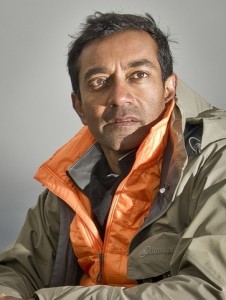September 16, 2015
A Thought Leader Series Piece
By M. Sanjayan
 Note: M. Sanjayan is a leading ecologist, speaker, writer and Emmy-nominated news contributor focused on the role of conservation in improving human well-being, wildlife and the environment. He serves on Conservation International’s senior leadership team as executive vice president and senior scientist, and is the host of the 2015 PBS TV series, Earth – A New Wild.
Note: M. Sanjayan is a leading ecologist, speaker, writer and Emmy-nominated news contributor focused on the role of conservation in improving human well-being, wildlife and the environment. He serves on Conservation International’s senior leadership team as executive vice president and senior scientist, and is the host of the 2015 PBS TV series, Earth – A New Wild.
When asked to visualize nature, we tend to picture a rain forest, coral reef or African savannah – a place busy with countless plant and animal species. But there’s something missing from that picture, something that profoundly influences every one of those scenes. The missing piece is people.
What does the real picture of nature look like? In my recent PBS project EARTH: A New Wild, we took what was essentially a natural history series and deliberately brought people into the frame. The point was to help show the essential connections between nature and the people who live with it.
For one segment, we traveled to Malawi, home to one of the largest freshwater lakes in the world. Lake Malawi has the highest diversity of freshwater fish on the planet – 800 plus species, half of them unnamed and all belonging to the cichlid family. The people who live around the lake wash in its waters and fish from its shores daily.
In the 1980s, this region of Malawi experienced a startling outbreak of bilharzia – a disease caused by a parasite that burrows through human skin. The parasite breeds in the liver, damaging organs and increasing susceptibility to HIV.
What caused the outbreak was a mystery until university professor Jay Stauffer discovered that the parasites were carried by a freshwater snail that had invaded shallow swimming waters. The invasion occurred after stocks of placodon – a snail-eating cichlid – diminished due to overfishing.
The take-home of this segment is clear: the health of Lake Malawi and that of the people who reside near it are intimately connected.
In recognizing our rightful place in this picture of nature, what can be done to correct the course of degradation and extinction we have initiated?
Efforts to connect a monetary value to nature can be effective in encouraging protection, particularly when it comes to public policy. For far too long, “saving nature” was regarded as something to be done when other human needs were met. Now, experts regard nature’s benefits as services to people and determine their value by calculating the cost of replacing, or going without, them.
Another tactic is the landscape approach, which works to maintain the interconnectedness of systems across boundaries. There is little point, for example, in protecting tuna in one area if they can swim to, and be overfished in, another. Conservation International emphasizes this kind landscape-based approach by focusing efforts at scales as large as the Amazon Basin or Pacific Ocean.
To better engage the public in the conservation conversation, it is absolutely critical that the dialogue reflect the diversity of people affected by proposed policies and outcomes – particularly in regions where our biggest challenges lie. When half the world’s population resides in Asia, for example, there should be more than one Asian in the conference room.
If conservation fails to become more inclusive – in terms of both ethnicity and gender – it will remain a niche issue rather than a way of life.
As for what we can do individually, volunteering, leading a campaign and making donations are all valuable endeavors. The most powerful tools we have at hand are our votes and our dollars. What we publicly support, as well as what we buy, matters. And because friends, family and neighbors are greater influencers of opinion than a scientist on a podium, we shouldn’t hesitate to engage in social media around issues we care about.
Today, there are few places on the planet that humans have not influenced, yet the idea that we are somehow separate from nature persists. It is easy to lose sight of the fact that we as a species are entirely dependent on nature. It supplies the air we breathe, the water we drink, and plays pivotal roles in food security and climate regulation.
In the words of Conservation International’s series Nature is Speaking, “Nature doesn’t need people. People need nature.” Seeing ourselves in the picture is the first step in creating a mindset where we actively protect what sustains us.
For a condensed video of Sanjayan's Earth Month Wrigley Lecture, "Saving Nature in a Human-Dominated World," click here.

